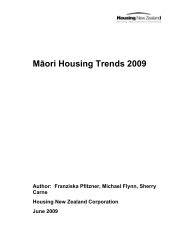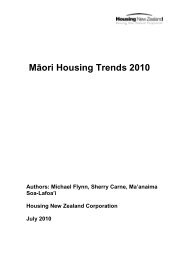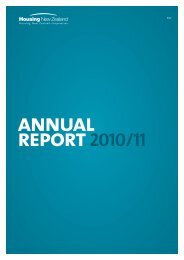Annual Report 2009/10 - Housing New Zealand
Annual Report 2009/10 - Housing New Zealand
Annual Report 2009/10 - Housing New Zealand
- No tags were found...
You also want an ePaper? Increase the reach of your titles
YUMPU automatically turns print PDFs into web optimized ePapers that Google loves.
housing new zealand corporation | notes to the financial statements continued2 Summary of significant accounting policies continued(g) Rental property land and buildings<strong>Housing</strong> for community groups held by <strong>Housing</strong> <strong>New</strong> <strong>Zealand</strong> Corporation, and state housing held by<strong>Housing</strong> <strong>New</strong> <strong>Zealand</strong> Limited is categorised on purchase or construction at cost. Such cost includes the costof repairs and maintenance that are eligible for capitalisation. All other repairs and maintenance cost arerecognised in the net surplus/(deficit) for the year.Each year, rental property, land and buildings are revalued, on a class basis, to fair value.Fair value is determined by reference to market-based evidence and is the amount for which the assets couldbe exchanged between a knowledgeable willing buyer and a knowledgeable willing seller in an arm’s lengthtransaction as at the valuation date.Independent valuations are performed annually to ensure that the carrying amount does not differ materiallyfrom the asset’s fair value at the balance date.Any revaluation surplus is recognised in the asset revaluation reserve in other comprehensive income exceptto the extent that it offsets a previous revaluation deficit for the same asset class that was recognised in thenet surplus/(deficit) for the year. Therefore, the surplus is recognised in the net surplus/(deficit) for the year.Any revaluation deficit is recognised in the net surplus/(deficit) for the year except to the extent that it offsetsa previous revaluation surplus for the same asset class that was recognised in the asset revaluation reserve.Therefore, the deficit is offset to the extent of the credit balance existing in the revaluation reserve for that asset.An item of property is derecognised upon disposal or when no future economic benefits are expected to arisefrom the continued use of this asset. Upon disposal, any revaluation reserve relating to the particular assetbeing sold is transferred to retained earnings. Any gain or loss arising on derecognition of an asset is includedin the net surplus/(deficit) for the year, in the period the item is derecognised. Gain or loss on derecognition iscalculated as the difference between the net disposal proceeds and the carrying amount of the item.Depreciation is calculated on a straight-line basis over the estimated useful life of the building as follows:Rental properties40 years(h) Work in progressConstruction work in progress is recognised at cost. On completion, the property will be held by the sameentity, whereupon it will be accounted for as rental property.(i) Property intended for saleProperty previously held but now being sold as it is no longer required is classified as a property held for sale.This classification is used where the carrying amount of the property will be recovered through sale, theproperty is available for immediate sale in its present condition and sale is highly probable.Property held for sale is recorded at the lower of the carrying amount and fair value less costs to sell. From thetime a property is classified as held for sale, depreciation is no longer charged on the improvements.Where property is held for sale or for development for sale, in the ordinary course of business, it is classifiedas inventory. Such property is recorded at the lower of cost and net realisable value (selling price less coststo complete and sale costs). Any write-downs to net realisable value are expensed in the net surplus/(deficit)for the year.HNZC Property Developments Limited’s (PDL) business is to subdivide large pieces of land where the Groupdoes not intend to retain the resulting titles. PDL will not retain any properties for the long term. As PDLproperty is held for development for sale, in the ordinary course of business, it is classified as inventory.( j) Borrowing costsBorrowing costs are recognised as an expense in the period in which they are incurred.92housing new zealand corporation | annual report <strong>2009</strong>/<strong>10</strong>














